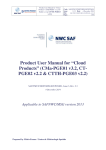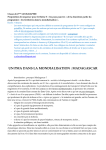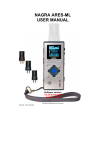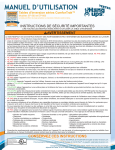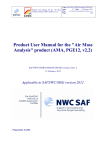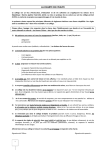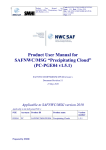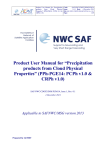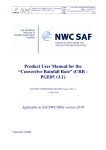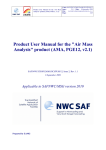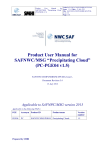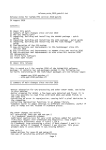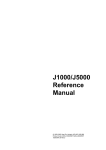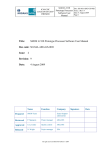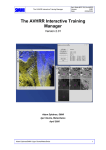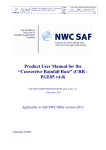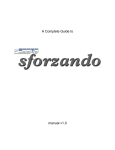Download Product User Manual for “Cloud Products”
Transcript
Product User Manual for “Cloud Products” (CMa-PGE01 v3.2, CTPGE02 v2.2 & CTTH-PGE03 v2.2) Code: Issue: File: Page: SAF/NWC/CDOP/MFL/SCI/PUM/01 3.2 Date: 15 February 2012 SAF-NWC-CDOP-MFL-SCI-PUM-01_v3.2 Product User Manual for “Cloud Products” (CMa-PGE01 v3.2, CTPGE02 v2.2 & CTTH-PGE03 v2.2) SAF/NWC/CDOP/MFL/SCI/PUM/01, Issue 3, Rev. 2 15 February 2012 Applicable to SAFNWC/MSG version 2012 Prepared by Météo-France / Centre de Météorologie Spatiale 1/32 Product User Manual for “Cloud Products” (CMa-PGE01 v3.2, CTPGE02 v2.2 & CTTH-PGE03 v2.2) Code: Issue: File: Page: SAF/NWC/CDOP/MFL/SCI/PUM/01 3.2 Date: 15 February 2012 SAF-NWC-CDOP-MFL-SCI-PUM-01_v3.2 2/32 REPORT SIGNATURE TABLE Function Prepared by Reviewed by Name Marcel Derrien MF/DP/CMS Hervé Le Gléau MF/DP/CMS Signature Date 15 February 2012 15 February 2012 Pilar Fernandez Authorised by SAFNWC Project Manager 15 February 2012 Product User Manual for “Cloud Products” (CMa-PGE01 v3.2, CTPGE02 v2.2 & CTTH-PGE03 v2.2) Code: Issue: File: Page: SAF/NWC/CDOP/MFL/SCI/PUM/01 3.2 Date: 15 February 2012 SAF-NWC-CDOP-MFL-SCI-PUM-01_v3.2 3/32 DOCUMENT CHANGE RECORD Version 1.4 Date 7 November 2007 2.0 3.0 3.1 3.2 23 August 2008 17 may 2010 24 march 2011 15 February 2012 Pages CHANGE(S) 30 Initial version (content derived from “User manual for PGE01-02-03 v1.3 (Cloud Products) of the SAFNWC/MSG: scientific part”) 31 Content adapted to version v2.0 33 Content adapted to version v3.0 32 Content adapted to version v3.1 32 Content adapted to version v3.2 Product User Manual for “Cloud Products” (CMa-PGE01 v3.2, CTPGE02 v2.2 & CTTH-PGE03 v2.2) Code: Issue: File: Page: SAF/NWC/CDOP/MFL/SCI/PUM/01 3.2 Date: 15 February 2012 SAF-NWC-CDOP-MFL-SCI-PUM-01_v3.2 4/32 Table of contents 1. INTRODUCTION ...................................................................................................................7 1.1 SCOPE OF THE DOCUMENT .......................................................................................................7 1.2 SCOPE OF OTHER DOCUMENTS.................................................................................................7 1.3 SOFTWARE VERSION IDENTIFICATION .....................................................................................7 1.4 IMPROVEMENT FROM PREVIOUS VERSION ................................................................................7 1.5 DEFINITIONS, ACRONYMS AND ABBREVIATIONS ....................................................................7 1.6 REFERENCES ...........................................................................................................................8 1.6.1 Applicable Documents...................................................................................................8 1.6.2 Reference Documents ....................................................................................................8 2. CLOUD MASK (CMA) PRODUCT......................................................................................9 2.1 DESCRIPTION OF CLOUD MASK (CMA) PRODUCT.....................................................................9 2.1.1 Goal of Cloud Mask (CMa) product .............................................................................9 2.1.2 Outline of Cloud Mask (CMa) algorithm .....................................................................9 2.1.3 Description of Cloud Mask (CMa) output...................................................................11 2.2 IMPLEMENTATION OF CLOUD MASK (CMA) .........................................................................12 Manual preparation of Cloud Mask (CMa) model configuration file for each region ...............13 2.2.2 The Cloud Mask (CMa) preparation step (optional)...................................................13 2.2.3 The Cloud Mask (CMa) execution step .......................................................................13 2.3 INPUTS AND CONFIGURABLE PARAMETERS FOR CLOUD MASK (CMA)...................................14 2.3.1 List of inputs for Cloud Mask (CMa) ..........................................................................14 2.3.2 Configurable parameters for Cloud Mask (CMa).......................................................15 2.4 CLOUD MASK (CMA) VALIDATION .......................................................................................15 2.4.1 Summary of Cloud Mask (CMa) validation results .....................................................15 2.4.2 Typical known problems and recommendation for use ...............................................16 2.5 EXAMPLE OF CLOUD MASK (CMA) VISUALISATION .............................................................16 3. CLOUD TYPE (CT) PRODUCT .........................................................................................18 3.1 DESCRIPTION OF CLOUD TYPE (CT) PRODUCT ......................................................................18 3.1.1 Goal of Cloud Type (CT) product ...............................................................................18 3.1.2 Outline of Cloud Type (CT) algorithm ........................................................................18 3.1.3 Description of Cloud Type (CT) output.......................................................................18 3.2 IMPLEMENTATION OF CLOUD TYPE (CT) ..............................................................................20 3.2.1 Manual preparation of Cloud Type (CT) model configuration file for each region ...20 3.2.2 The Cloud Type (CT) preparation step (optional).......................................................21 3.2.3 The Cloud Type (CT) execution step ...........................................................................21 3.3 INPUTS AND CONFIGURABLE PARAMETERS FOR CLOUD TYPE (CT) .......................................21 3.3.1 List of inputs for Cloud Type (CT) ..............................................................................21 3.3.2 Configurable parameters for Cloud Type (CT)...........................................................22 3.4 CLOUD TYPE (CT) VALIDATION ...........................................................................................23 3.4.1 Summary of Cloud Type (CT) validation results.........................................................23 3.4.2 Typical known problems and recommendation for use ...............................................23 3.5 EXAMPLE OF CLOUD TYPE (CT) VISUALISATION ..................................................................23 4. CLOUD TOP TEMPERATURE AND HEIGHT (CTTH) PRODUCT...........................25 4.1 DESCRIPTION OF CLOUD TOP TEMPERATURE AND HEIGHT (CTTH) PRODUCT ......................25 4.1.1 Goal of Cloud Top Temperature and Height (CTTH) product ...................................25 4.1.2 Outline of Cloud Top Temperature and Height (CTTH) algorithm ............................25 4.1.3 Description of Cloud Top Temperature and Height (CTTH) output...........................26 4.2 IMPLEMENTATION OF CLOUD TOP TEMPERATURE AND HEIGHT (CTTH) ..............................28 Product User Manual for “Cloud Products” (CMa-PGE01 v3.2, CTPGE02 v2.2 & CTTH-PGE03 v2.2) Code: Issue: File: Page: SAF/NWC/CDOP/MFL/SCI/PUM/01 3.2 Date: 15 February 2012 SAF-NWC-CDOP-MFL-SCI-PUM-01_v3.2 5/32 4.2.1 Manual preparation of Cloud Top Temperature and Height (CTTH) model configuration file for each region................................................................................................29 4.2.2 The Cloud Top Temperature and Height (CTTH) preparation step (optional)...........29 4.2.3 The Cloud Top Temperature and Height (CTTH) execution step ...............................29 4.3 INPUTS AND CONFIGURABLE PARAMETERS FOR CLOUD TOP TEMPERATURE AND HEIGHT (CTTH)............................................................................................................................................29 4.3.1 List of inputs for Cloud Top Temperature and Height (CTTH) ..................................29 4.3.2 Configurable parameters for Cloud Top Temperature and Height (CTTH)...............31 4.4 CLOUD TOP TEMPERATURE AND HEIGHT (CTTH) VALIDATION ...........................................31 4.4.1 Summary of Cloud Top Temperature and Height (CTTH) validation results.............31 4.4.2 Typical known problems and recommendation for use ...............................................31 4.5 EXAMPLE OF CLOUD TOP TEMPERATURE AND HEIGHT (CTTH) VISUALISATION ...................32 Product User Manual for “Cloud Products” (CMa-PGE01 v3.2, CTPGE02 v2.2 & CTTH-PGE03 v2.2) Code: Issue: File: Page: SAF/NWC/CDOP/MFL/SCI/PUM/01 3.2 Date: 15 February 2012 SAF-NWC-CDOP-MFL-SCI-PUM-01_v3.2 6/32 List of Tables and Figures Table 1: List of Applicable Documents.............................................................................................8 Table 2: List of Referenced Documents............................................................................................8 Table 3: Test sequence over land ....................................................................................................10 Table 4: Test sequence over sea ......................................................................................................10 Table 5: Summary of validation results of the current PGE01 version (POD stands for Percentage Of Detection). .........................................................................................................................16 Table 6: Summary of validation results of the current PGE02 version.[AD. 5] .............................23 Table 7: Summary of validation results of the current PGE03 version (std stands for standard deviation). ...............................................................................................................................31 Figure 1: Example of SEVIRI dust cloud flag superimposed on a 10.8μm infrared image: dust cloud over North Africa on 14th July 2003 at 13h00 UTC. .....................................................17 Figure 2: Example of MODIS volcanic ash cloud superimposed on a 10.8μm infrared image: Etna eruption on 22th July 2001 at 9h55 UTC. ...............................................................................17 Figure 3: Example of SEVIRI CT cloud type using the colour palette included in CT HDF files. 24 Figure 4 Example of SEVIRI CT cloud phase using the colour palette included in CT HDF files. .................................................................................................................................................24 Figure 5: Example of SEVIRI CTTH cloud top pressure ...............................................................32 Product User Manual for “Cloud Products” (CMa-PGE01 v3.2, CTPGE02 v2.2 & CTTH-PGE03 v2.2) Code: Issue: File: Page: SAF/NWC/CDOP/MFL/SCI/PUM/01 3.2 Date: 15 February 2012 SAF-NWC-CDOP-MFL-SCI-PUM-01_v3.2 7/32 1. INTRODUCTION The Eumetsat “Satellite Application Facilities” (SAF) are dedicated centres of excellence for processing satellite data, and form an integral part of the distributed EUMETSAT Application Ground Segment (http://www.eumetsat.int). This documentation is provided by the SAF on Support to Nowcasting and Very Short Range Forecasting, SAFNWC. The main objective of SAFNWC is to provide, further develop and maintain software packages to be used for Nowcasting applications of operational meteorological satellite data by National Meteorological Services. More information can be found at the SAFNWC webpage, http://nwcsaf.org . This document is applicable to the SAFNWC processing package for Meteosat Second Generation satellites, SAFNWC/MSG. 1.1 SCOPE OF THE DOCUMENT This document is the Product User Manual for MSG cloud products PGE01 (CMa), PGE02 (CT) and PGE03 (CTTH). This document contains practical information on the characteristics of the above mentioned products, on their applicability and limitations. 1.2 SCOPE OF OTHER DOCUMENTS The algorithms used to extract the MSG Cloud Products PGE01 (CMa), PGE02 (CT) and PGE03 (CTTH) are detailed in the algorithm theoretical basis document for cloud products ( [AD. 4]). The validation of the algorithms used to extract the MSG Cloud Products PGE01 (CMa), PGE02 (CT) and PGE03 (CTTH) is reported in the validation report for cloud products ([AD. 5]). Instructions to install, configure and execute the SAFNWC/MSG software in order to extract the MSG Cloud Products PGE01 (CMa), PGE02 (CT) and PGE03 (CTTH) are detailed in the software user manual (AD. 3). The interface control documents (AD. 1) (for the External and Internal Interfaces of the SAFNWC/MSG) and (AD. 2) (MSG Output Product Format Definition) detail the input and output data format for the SAFNWC/MSG software. 1.3 SOFTWARE VERSION IDENTIFICATION This document describes the products obtained from the CMa-PGE01 V3.2, CT-PGE02 v2.2 and CTTH-PGE03 v2.2 implemented in the release2012 of the SAFNWC/MSG software package. 1.4 IMPROVEMENT FROM PREVIOUS VERSION CMa, CT and CTTH algorithms remain unchanged since previous version (v2011). 1.5 DEFINITIONS, ACRONYMS AND ABBREVIATIONS CMa CMS CTTH CT ECMWF Cloud Mask (also PGE01) Centre de Meteorologie Spatiales (Météo-France, satellite reception centre in Lannion) Cloud Top Temperature and Height Cloud Type European Centre for Medium range Weather Forecast Product User Manual for “Cloud Products” (CMa-PGE01 v3.2, CTPGE02 v2.2 & CTTH-PGE03 v2.2) EUMETSAT FOV HDF HRIT HRV ICD MSG NWP PGE PUM R0.6μm RTMOM RTTOV SAF SAF NWC SAF OSI SEVIRI SW T11μm Code: Issue: File: Page: SAF/NWC/CDOP/MFL/SCI/PUM/01 3.2 Date: 15 February 2012 SAF-NWC-CDOP-MFL-SCI-PUM-01_v3.2 8/32 European Organisation for the Exploitation of Meteorological Satellites Field Of View Hierarchical data Format High Rate Information Transmission High Resolution Visible Interface Control Document Meteosat Second Generation Numerical Weather Prediction Product Generation Element Product User Manual 0.6 visible reflectance Radiative Transfer based on Matrix Operator Method Rapid Transmissions for TOVs Satellite Application Facility SAF on support to NoWCasting and VSRF Ocean and Sea Ice SAF Spinning Enhanced Visible & Infrared Imager Software 11 micrometer infrared brightness temperature 1.6 REFERENCES 1.6.1 Applicable Documents Reference [AD. 1] [AD. 2] [AD. 3] [AD. 4] [AD. 5] Title Interface Control Document for the External and Internal Interfaces of the SAFNWC/MSG SAFNWC/MSG Output Products Format Definition Software User Manual for the SAFNWC/MSG application Algorithm Theoretical Basis Document for “Cloud Products” (CMa-PGE01 v3.2, CTPGE02 v2.2 & CTTH-PGE03 v2.2) Validation Report for “Cloud Products” (CMaPGE01 v3.2, CT-PGE02 v2.2 & CTTH-PGE03 v2.2) Code SAF/NWC/IOP/INM/SW/ICD/1 Vers 2.0 Date SAF/NWC/IOP/INM/SW/ICD/3 2.0 SAF/NWC/IOP/INM/SW/SUM/2 2.0 SAF/NWC/CDOP/MFL/SCI/ATB D/01 3.2 15/02/12 SAF/NWC/CDOP/MFL/SCI/VR/06 1.0 15/02/12 Vers Date Table 1: List of Applicable Documents 1.6.2 Reference Documents Reference [RD.1] [RD.2] Title Code Table 2: List of Referenced Documents Product User Manual for “Cloud Products” (CMa-PGE01 v3.2, CTPGE02 v2.2 & CTTH-PGE03 v2.2) Code: Issue: File: Page: SAF/NWC/CDOP/MFL/SCI/PUM/01 3.2 Date: 15 February 2012 SAF-NWC-CDOP-MFL-SCI-PUM-01_v3.2 9/32 2. CLOUD MASK (CMA) PRODUCT 2.1 DESCRIPTION OF CLOUD MASK (CMA) PRODUCT 2.1.1 Goal of Cloud Mask (CMa) product The cloud mask (CMa), developed within the SAF NWC context, aims to support nowcasting applications, and additionally the remote-sensing of continental and oceanic surfaces. The CMa allows identifying cloud free areas where other products (total or layer precipitable water, land or sea surface temperatures, snow/ice cover delineation) may be computed. It also allows identifying cloudy areas where other products (cloud types and cloud top temperature/height) may be derived. The central aim of the CMa is therefore to delineate all cloud-free pixels in a satellite scene with a high confidence. In addition, the product provides information on the presence of snow/sea ice, dust clouds and volcanic plumes. 2.1.2 Outline of Cloud Mask (CMa) algorithm The algorithm is based on multispectral threshold technique applied to each pixel of the image. A first process allows the identification of cloudy pixels. It consists in a first set of multispectral threshold tests (summed up below) which is complemented by an analysis of the temporal variation (on a short period of time: 15 minutes) of some spectral combinations of channels (to detect rapidly moving clouds), a specific treatment combining temporal coherency analysis and region growing technique (to improve the detection of low clouds) and a temporal analysis of the HRV channel (to detect sub-pixel cumulus clouds). The first series of tests allows the identification of pixels contaminated by clouds or snow/ice; this process is stopped if one test is really successful (i.e., if the threshold is not too close to the measured value). The characteristics of this set of tests are summed up below: • The tests, applied to land or sea pixels, depend on the solar illumination and on the viewing angles and are presented in Table 3 and Table 4. • Most thresholds are determined from satellite-dependent look-up tables (available in coefficients’ files) using as input the viewing geometry (sun and satellite viewing angles), NWP forecast fields (surface temperature and total atmospheric water vapour content) and ancillary data (elevation and climatological data). The thresholds are computed at a spatial resolution (called “segment size”) defined by the user as a number of SEVIRI infra-red pixels. Some thresholds are empirical constant or satellite-dependent values (available in coefficients’ files). • The quality of the cloud detection process is assessed. • A spatial filtering is applied, allowing to reclassify pixels having a class type different from their neighbours and to reduce known defaults as cloud false alarms in coastal area and in edges of snowy areas. • A test is applied to cloud contaminated pixels to check whether the cloud cover is opaque and completely fills the FOV. This first series of tests allows to determine the cloud cover category of each pixel (cloud-free, cloud contaminated, cloud filled, snow/ice contaminated or undefined/non processed) and compute a quality flag on the processing itself. Moreover, the tests that have allowed the cloud detection (more that one test are possible, if some tests were not really successful) are stored. Product User Manual for “Cloud Products” (CMa-PGE01 v3.2, CTPGE02 v2.2 & CTTH-PGE03 Code: Issue: File: Page: v2.2) SAF/NWC/CDOP/MFL/SCI/PUM/01 3.2 Date: 15 February 2012 SAF-NWC-CDOP-MFL-SCI-PUM-01_v3.2 10/32 A second process, allowing the identification of dust clouds and volcanic ash clouds, is applied to all pixels (even already classified as cloud-free or contaminated by clouds). The result is stored in the dust cloud and volcanic ash cloud flags. Details on the tests are given in the algorithm theoretical basis document for cloud products ([AD. 4]). Daytime Twilight Nighttime Snow detection Snow detection T10.8μm T10.8μm T10.8μm T10.8μm-T12.0μm R0.6μm R0.6μm T8.7μm-T10.8μm T10.8μm-T12.0μm T10.8μm-T12.0μm T10.8μm-T8.7μm T8.7μm-T10.8μm T8.7μm-T10.8μm T10.8μm-T3.9μm T10.8μm-T3.9μm T10.8μm-T8.7μm T3.9μm-T10.8μm T3.9μm-T10.8μm T10.8μm-T3.9μm Local Spatial Texture Local Spatial Texture T3.9μm-T10.8μm T8.7μm-T3.9μm Local Spatial Texture T8.7μm-T3.9μm Table 3: Test sequence over land Daytime Sunglint Twilight Nighttime Ice detection Ice detection Ice detection SST SST SST SST T10.8μm-T12.0μm R0.8μm (R0.6μm) T10.8μm-T12.0μm R0.8μm (R0.6μm) T8.7μm-T10.8μm R1.6μm T8.7μm-T10.8μm R1.6μm T10.8μm-T3.9μm T10.8μm-T12.0μm Local Spatial Texture T10.8μm-T12.0μm T12.0μm-T3.9μm T8.7μm-T10.8μm R0.8μm (R0.6μm) T8.7μm-T10.8μm T3.9μm-T10.8μm T10.8μm-T3.9μm T10.8μm-T3.9μm T10.8μm-T3.9μm Local Spatial Texture T3.9μm-T10.8μm Low Clouds in Sunglint T12.0μm-T3.9μm Local Spatial Texture T3.9μm-T10.8μm Local Spatial Texture Table 4: Test sequence over sea [T3.9μm, T8.7μm , T10.8μm and T12.0μm stand for brightness temperatures at 3.9, 8.7, 10.8 and 12.0 micrometer ; R0.6μm,R0.8μm and R1.6μm stand for VIS/NIR bi-directional top of atmosphere reflectances at 0.6, 0.8 and 1.6 micrometer normalised for solar illumination ; SST is the split-window (used for SST calculation) computed from T10.8μm and T12.0μm measurements. Low Clouds in Sunglint is a specific module for low clouds identification in sunglint areas.] Product User Manual for “Cloud Products” (CMa-PGE01 v3.2, CTPGE02 v2.2 & CTTH-PGE03 v2.2) Code: Issue: File: Page: SAF/NWC/CDOP/MFL/SCI/PUM/01 3.2 Date: 15 February 2012 SAF-NWC-CDOP-MFL-SCI-PUM-01_v3.2 11/32 2.1.3 Description of Cloud Mask (CMa) output The description of CMa output (in HDF format) is detailed in the output products format definition document (AD. 2). This section summarizes the CMa output fields (a colour palette is also included in the HDF CMa output file for each field, see 2.5). • 0 1 2 3 4 5 • The main product output consists in the following six categories coded on 3 bits Non-processed cloud-free containing no data or corrupted data no contamination by snow/ice covered surface, no contamination by clouds ; but contamination by thin dust/volcanic clouds not checked Cloud contaminated partly cloudy or semitransparent. May also include dust clouds or volcanic plumes. Cloud filled opaque clouds completely filling the FOV. May also include thick dust clouds or volcanic plumes. Snow/Ice contaminated Undefined has been processed but not classified due to known separability problems 16 bits to describe which test was successful For each cloudy pixel, the bits corresponding to the successful tests are activated. More than one bit may be activated, if tests were not really successful (measurement too close to thresholds)). 0 T10.8μm or SST 1 R0.6μm (land) or R0.8μm (sea) 2 Sunglint test using 3.9μm 3 Local Spatial Texture 4 T10.8μm - T12.0μm 5 T10.8μm - T3.9μm or T12.0μm - T3.9μm 6 T3.9μm - T10.8μm 7 Spatial smoothing (reclassify isolated cloud-free pixels) 8 T8.7μm - T3.9μm 9 R1.6μm (sea) 10 T8.7μm –T10.8μm or T10.8μm –T8.7μm 11 Snow using R1.6μm or T3.9μm 12 HRV-based test 13 Stationary cloud in twilight 14 Spatial expansion of stationary cloud in twilight 15 Temporal-differencing • 11 bits for quality 3 bits to define illumination and viewing conditions: 0 Undefined (space) 1 Night 2 Twilight 3 Day 4 Sunglint 2 bits to describe NWP input data 0 Undefined (space) 1 All NWP parameters available (no low level inversion) 2 All NWP parameters available (low level inversion) 3 At least one NWP parameter missing Product User Manual for “Cloud Products” (CMa-PGE01 v3.2, CTPGE02 v2.2 & CTTH-PGE03 v2.2) Code: Issue: File: Page: SAF/NWC/CDOP/MFL/SCI/PUM/01 3.2 Date: 15 February 2012 SAF-NWC-CDOP-MFL-SCI-PUM-01_v3.2 12/32 2 bits to describe SEVIRI input data 0 Undefined (space) 1 All useful SEVIRI channels available ; 2 At least one useful SEVIRI channel missing 3 A least one mandatory SEVIRI channel missing 2 bits to describe the quality of the processing itself: 0 Non processed (containing no data or corrupted data) 1 Good quality (high confidence) 2 Poor quality (low confidence) 3 Reclassified after spatial smoothing (very low confidence) 1 bit for temporal processing indicator (significant for cloud-free pixels) 0 Not performed 1 Performed 1 bit for HRV processing indicator (significant for cloud-free pixels) 0 Not performed 1 Performed • 0 1 2 3 • 0 1 2 3 2 bits for dust detection Non processed (containing no data or corrupted data) dust non dust undefined (due to known separability problems) 2 bits for volcanic plume detection Non processed (containing no data or corrupted data) volcanic plume non volcanic plume undefined (due to known separability problems) 2.2 IMPLEMENTATION OF CLOUD MASK (CMA) CMa is extracted by PGE01 of the SAFNWC/MSG software package. Detailed information on how to run this software package is available in the software user manual (AD. 3). The software architecture of PGE01 has been strongly modified in version v2010 (to make the life easier for the user). It is now very similar to the other PGEs. When a new region is defined the user has now to manually prepare the CMa model configuration files for this new region using a default CMa model configuration file provided in the SAFNWC/MSG software package. There is an option for the user to monitor the so-called CMa preparation step before SEVIRI images are available (to speed up the process). By default, this preparation step is performed during the CMa execution step. The CMa execution step (which includes the CMa preparation step in case it has not been launched before) is automatically launched by the Task Manager (if real-time environment is selected). Product User Manual for “Cloud Products” (CMa-PGE01 v3.2, CTPGE02 v2.2 & CTTH-PGE03 v2.2) Code: Issue: File: Page: SAF/NWC/CDOP/MFL/SCI/PUM/01 3.2 Date: 15 February 2012 SAF-NWC-CDOP-MFL-SCI-PUM-01_v3.2 13/32 2.2.1 Manual preparation of Cloud Mask (CMa) model configuration file for each region When a new region is defined and added in system and run configuration files, the user must manually prepares the CMa model configuration files by adapting the CMa default model configuration file available in the SAFNWC software package. Three parameters are configurable in the default CMa model configuration file: • CMA_SZSEG (default value: 4): the size of the segment for CMa. The new segment size must also be updated in the lines NWP_PARAMxx [Segments are square boxes in the satellite projection, whose size is expressed as the number of IR pixels of one edge of the square box. The size of the processed regions must be a multiple of the segment size. All the solar and satellite angles, the NWP model forecast values, the atlas values and the thresholds will be derived over all the processed regions at the horizontal resolution of the segment. Note also that the land/sea atlas will be available at the full IR resolution, allowing the identification of the surface type (land or sea) of all IR pixels, whatever the segment size. The quality is not very much dependent of the segment size (if lower than 4). A segment size of 4 allows the preparation step to be 9 times faster than if a segment size of 1 was used] • TEMPORAL_USE (default value: TRUE): a flag defining if the temporal analysis should be done. [TEMPORAL_USE flag is checked at the execution step. PGE01 applies the temporal analysis if its value is TRUE. This flag has been made configurable to allow users being blocked by hardware resources to still run the PGE01 by assigning it to FALSE in the configuration file.] • HRV_NEED (default value: TRUE): a flag indicating whether the HRV analysis should be done. [HRV_NEED flag is checked at the execution step. PGE01 applies the HRV analysis if its value is TRUE. This flag has been made configurable to allow users being blocked by hardware resources to still run the PGE01 by assigning it to FALSE in the configuration file.] When required and when the 2 HRV images required by the algorihm are not available the PGE01 is processed without this enhancement. For regions being partially covered by HRV measurements, only the SEVIRI pixels having HRV benefit from enhancement. Moreover as the content of NWP_CONF_FILE is dependent on the local installation, the user must make the NWP_PARAMXX consistent with the local NWP_CONF_FILE when the standard one is not used (for details see section dedicated to NWP data files in SAF/NWC/CDOP/INM/SW/SUM/2 [AD. 3]) . 2.2.2 The Cloud Mask (CMa) preparation step (optional) By default, this CMa preparation step is performed during the CMa execution step (see 2.2.3). But to speed up the CMa processing, this preparation step can performed by the command mfcms_next_pge01 which can be launched in advance of satellite data reception according to a pre-defined time scheduling to be manually set by the user. This preparation step includes the computation on the region at the segment spatial resolution of: • the solar & satellite angles, • the monthly climatological & atlas maps, • the thresholds for the CMa algorithm 2.2.3 The Cloud Mask (CMa) execution step The CMa execution step (which by default includes the CMa preparation step see 2.2.2) is the real-time processing of the SEVIRI images itself over the region. This process consists in the launch of the command: PGE01 by the Task manager. The cloud masking is then performed, using the thresholds prepared during the preparation step. Product User Manual for “Cloud Products” (CMa-PGE01 v3.2, CTPGE02 v2.2 & CTTH-PGE03 Code: Issue: File: Page: v2.2) SAF/NWC/CDOP/MFL/SCI/PUM/01 3.2 Date: 15 February 2012 SAF-NWC-CDOP-MFL-SCI-PUM-01_v3.2 14/32 2.3 INPUTS AND CONFIGURABLE PARAMETERS FOR CLOUD MASK (CMA) 2.3.1 List of inputs for Cloud Mask (CMa) The input data to the CMa algorithm are described in this section. Mandatory inputs are flagged, whereas the impact of missing non-mandatory data on the processing are indicated. • Satellite imagery: The following SEVIRI bi-directional reflectances or brightness temperatures of the scene to be analysed are needed at full IR spatial resolution (at HRV spatial resolution for HRV): HRV R0.6μm R0.8μm R1.6μm T3.9μm T7.3μm T8.7μm T10.8μm T12.0μm T13.4μm Optional Mandatory Optional Optional Mandatory Optional Optional Mandatory Mandatory Optional The CMa software checks the availability of SEVIRI channels for each pixel. If non mandatory channels are missing for one pixel, the tests using these channels are not applied, or applied differently (for example, snow detection uses either R1.6μm or T3.9μm; visible channel test over the ocean uses either R0.8μm or R0.6μm) and a result is available for this pixel. No results are provided for pixels where at least one mandatory channel is missing. The following SEVIRI bi-directional reflectances or brightness temperatures or Cma or CT of the scene analysed one hour sooner are optionally needed to improve the cloud detection in day-night transition. If one of them misses this improvement is not performed. R0.6μm1h Optional T8.7μm1h Optional T10.8μm1h T12.0μm1h Optional Optional CMa1h Optional CT1h Optional The following SEVIRI brightness temperatures or Cma or CT of the scene analysed 15 minutes sooner are optionally needed to improve the cloud detection of fast moving clouds. If one of them misses this improvement is not performed. T8.7μm15mn Optional T10.8μm15mn Optional T12.0μm15mn Optional CMa15mn Optional CT15mn Optional The HRV bi-directional reflectance of the scene analysed 15 minutes sooner are optionally needed to improve the sub-pixel cumulus cloud detection. If not available this improvement is not performed. HRV15mn Optional The SEVIRI channels are input by the user in HRIT format, and extracted on the processed region by SAFNWC software package. • Sun and satellite angles associated to SEVIRI imagery This information is mandatory. It is computed by the CMa software itself, using the definition of the region and the satellite characteristics. • NWP parameters: The forecast fields of the following parameters, remapped onto satellite images, are used as input : o surface temperatures (required to get good quality results over land ; but not mandatory) o air temperature at 950hPa (alternatively 925hPa). Used to check low level inversion. o total water vapour content of the atmosphere, o altitude of the NWP model grid (alternatively surface geopotential on the NWP model grid). Required if NWP fields are used as input. Product User Manual for “Cloud Products” (CMa-PGE01 v3.2, CTPGE02 v2.2 & CTTH-PGE03 v2.2) Code: Issue: File: Page: SAF/NWC/CDOP/MFL/SCI/PUM/01 3.2 Date: 15 February 2012 SAF-NWC-CDOP-MFL-SCI-PUM-01_v3.2 15/32 These remapped fields are elaborated by the SAFNWC software package from the NWP fields input by the user in GRIB format. The NWP fields are not mandatory: the CMa software replaces missing NWP surface temperatures or total water vapour content of the atmosphere by climatological values extracted from ancillary dataset, but the quality of CMa is then lower. • Ancillary data sets: The following ancillary data, remapped onto satellite images, are mandatory : o Land/sea atlas o Land/sea/coast atlas o Elevation atlas o Monthly minimum SST climatology o Monthly mean 0.6μm atmospheric-corrected reflectance climatology (land) o Monthly mean large band visible surface reflectance climatology (land, for HRV processing) o Monthly integrated atmospheric water vapour content climatology o Monthly climatology of mean air temperature at 1000 hPa These ancillary data are available in the SAFNWC software package on MSG full disk in the default satellite projection at full IR resolution; They are extracted on the processed region by the CMa software itself. Coefficients’s file (also called threshold tables), containing satellite-dependent values and look-up tables for IR thresholds and for solar channels’ thresholds, are available in the SAFNWC software package, and are needed by the CMa software. 2.3.2 Configurable parameters for Cloud Mask (CMa) Three configurables parameters are available in the default CMa model configuration file: • CMA_SZSEG: The size of the segment is configurable (see its definition in 2.2.1). Its default value is 4. Information on how to change the size of the segment can be found in the software user manual (AD. 3) and in section 2.2.1. • TEMPORAL_USE: The flag defining if temporal information is to be used (to allow a better detection of fast moving clouds and low clouds in twilight conditions) is configurable (see its definition in 2.2.1). Its default value is TRUE. Information on how to change this value can be found in the software user manual (AD. 3) and in section 2.2.1. • HRVNEED: The flag indicating if HRV data have to be used (to allow enhanced sub-pixel cumulus detection) is configurable (see its definition in 2.2.1). Its default value is TRUE. Information on how to change this value can be found in the software user manual (AD. 3) and in section 2.2.1. 2.4 CLOUD MASK (CMA) VALIDATION 2.4.1 Summary of Cloud Mask (CMa) validation results Table 5 summarises the validation results of the current version. More details can be obtained from the validation report for cloud products ([AD. 5]). PGE01 flags Validated accuracy PGE01 cloud detection Product User Manual for “Cloud Products” (CMa-PGE01 v3.2, CTPGE02 v2.2 & CTTH-PGE03 v2.2) validated over European areas using SYNOP observations PGE01 dust flag validated over sea and Africa for solar elevation larger than 20 degrees using interactive targets Code: Issue: File: Page: SAF/NWC/CDOP/MFL/SCI/PUM/01 3.2 Date: 15 February 2012 SAF-NWC-CDOP-MFL-SCI-PUM-01_v3.2 16/32 POD:96.5% POD: 55.5% over sea 58.5% over land Table 5: Summary of validation results of the current PGE01 version (POD stands for Percentage Of Detection). 2.4.2 Typical known problems and recommendation for use The following problems may be encountered: • Low clouds may be not detected in case low solar elevation, over both sea and land. • It may happen that large areas of low clouds are not detected in night-time conditions over land. This can be the case in “warm sectors”, but also in areas viewed with high satellite zenith angles or if the low clouds are surmounted by very thin cirrus. • Snowy grounds are not detected at night-time and therefore may confused either with low clouds or cloud free surface. This drawback has been reduced with v3.1 in release2011. • False detection of volcanic ash clouds happens especially in daytime conditions (over low clouds and desertic surfaces), but also in night-time (over cold clouds). The volcanic ash clouds detection is not performed in case low solar elevation. • Over land, dust cloud detection is performed only at daytime. Over land, dust clouds are not well detected when the sun is low or if they are too thin. Over sea, some dust areas may not be detected (especially the thinnest parts). Moreover, some wrong detection may be observed in oceanic regions, especially at nighttime near Namibia coast and occasionally over the South Atlantic (at latitude larger than 50 degrees). The CMa product may be used to identify cloud-free surfaces for oceanic or continental surface parameters retrieval. Nevertheless, as some clouds remains undetected and to account for artefacts such as shadows or aerosols, the user should apply a post-processing which could include: • the spreading of the cloud mask that should allow to detect cloud edges and mask shadows or moist areas near cloud edges • the use of the cloud mask quality flag not to compute surface parameters in bad quality cloud free areas • the implementation of an additional filtering based on the temporal variation around the current slot 2.5 EXAMPLE OF CLOUD MASK (CMA) VISUALISATION It is important to note that the CMa product is not just images, but numerical data. At first hand, the CMa is rather thought to be used digitally (together with the appended flags (quality, dust detection, volcanic ash detection)) as input to mesoscale analysis models, objective Nowcasting schemes, but also during the extraction of other SAFNWC products (CT for example). Colour palettes are included in CMa HDF files, allowing an easy visualisation of CMa main categories, dust and volcanic ash clouds flags. No example of CMa main categories’s visualisation are given, as it is thought that the user will be more interested to visualize the CT product which can be seen as a refinement. Product User Manual for “Cloud Products” (CMa-PGE01 v3.2, CTPGE02 v2.2 & CTTH-PGE03 v2.2) Code: Issue: File: Page: SAF/NWC/CDOP/MFL/SCI/PUM/01 3.2 Date: 15 February 2012 SAF-NWC-CDOP-MFL-SCI-PUM-01_v3.2 17/32 Example of visualisation of the dust cloud and the volcanic ash cloud flags superimposed on infrared images are given in Figure 1 and Figure 2 , using SEVIRI and MODIS imagery. Figure 1: Example of SEVIRI dust cloud flag superimposed on a 10.8μm infrared image: dust cloud over North Africa on 14th July 2003 at 13h00 UTC. Figure 2: Example of MODIS volcanic ash cloud superimposed on a 10.8μm infrared image: Etna eruption on 22th July 2001 at 9h55 UTC. Product User Manual for “Cloud Products” (CMa-PGE01 v3.2, CTPGE02 v2.2 & CTTH-PGE03 v2.2) Code: Issue: File: Page: SAF/NWC/CDOP/MFL/SCI/PUM/01 3.2 Date: 15 February 2012 SAF-NWC-CDOP-MFL-SCI-PUM-01_v3.2 18/32 3. CLOUD TYPE (CT) PRODUCT 3.1 DESCRIPTION OF CLOUD TYPE (CT) PRODUCT 3.1.1 Goal of Cloud Type (CT) product The cloud type (CT), developed within the SAF NWC context, mainly aims to support nowcasting applications. The main objective of this product is to provide a detailed cloud analysis. It may be used as input to an objective meso-scale analysis (which in turn may feed a simple nowcasting scheme), as an intermediate product input to other products, or as a final image product for display at a forecaster’s desk. The CT product is essential for the generation of the cloud top temperature and height product and for the identification of precipitation clouds. Finally, it is also essential for the computation of radiative fluxes over sea or land, which are SAF Ocean & Sea Ice products. The CT product therefore contains information on the major cloud classes : fractional clouds, semitransparent clouds, high, medium and low clouds (including fog) for all the pixels identified as cloudy in a scene. A second priority is the distinction between convective and stratiform clouds (implementation not planned before 2012), and the identification of clouds for which the top mainly consists of water droplets. 3.1.2 Outline of Cloud Type (CT) algorithm The CT algorithm is a threshold algorithm applied at the pixel scale, based on the use of CMa and spectral & textural features computed from the multispectral satellite images and compared with a set of thresholds. The set of thresholds to be applied depends mainly on the illumination conditions, whereas the values of the thresholds themselves may depend on the illumination, the viewing geometry, the geographical location and NWP data describing the water vapour content and a coarse vertical structure of the atmosphere. Opaque clouds are first separated from semi-transparent and from fractional (sub-pixel) clouds using brightness temperature differences (T10.8μm-T12.0μm, T8.7μm-T10.8μm or T3.9μmT10.8μm) and R0.6μm (at daytime). Opaque clouds are then separated in very low, low, midlevel, high or very high clouds using their T10.8mm brightness temperatures which are compared to NWP forecast air temperatures at various pressure levels. Details are available in the algorithm theoretical basis document for cloud products ([AD. 4]). A separate processing is applied to compute the cloud phase flag, based on the use of CT cloud type, T8.7μm,T10.8μm (all illumination), R0.6μm and R1.6μm (at daytime). 3.1.3 Description of Cloud Type (CT) output The description of CT output (in HDF format) is detailed in the output products format definition document (AD. 2). This section summarizes the CT output fields (a colour palette is also included in the HDF CT output file for each field, see 3.5). • 0 1 The main product output consists in the following twenty-one categories coded on 5 bits non-processed containing no data or corrupted data cloud free land no contamination by snow/ice covered surface, Product User Manual for “Cloud Products” (CMa-PGE01 v3.2, CTPGE02 v2.2 & CTTH-PGE03 v2.2) Code: Issue: File: Page: SAF/NWC/CDOP/MFL/SCI/PUM/01 3.2 Date: 15 February 2012 SAF-NWC-CDOP-MFL-SCI-PUM-01_v3.2 19/32 no contamination by clouds ; but contamination by thin dust/volcanic clouds not checked cloud free sea no contamination by snow/ice covered surface, no contamination by clouds ; but contamination by thin dust/volcanic clouds not checked land contaminated by snow sea contaminated by snow/ice very low and cumuliform clouds very low and stratiform clouds low and cumuliform clouds low and stratiform clouds medium and cumuliform clouds medium and stratiform clouds high opaque and cumuliform clouds high opaque and stratiform clouds very high opaque and cumuliform clouds very high opaque and stratiform clouds high semitransparent thin clouds high semitransparent meanly thick clouds high semitransparent thick clouds high semitransparent above low or medium clouds fractional clouds (sub-pixel water clouds) undefined (undefined by CMa) 2 3 4 5 6 7 8 9 10 11 12 13 14 15 16 17 18 19 20 In the current version of CT, the separation between cumuliform and stratiform is not performed: low, medium or high clouds will be classified as stratiform, and a specific bit indicating whether the separation between stratiform and cumuliform clouds has been attempted, will be set to zero (see below quality flag). • 10 bits for quality 3 bits to define illumination and viewing conditions: 0 Undefined (space) 1 Night 2 Twilight 3 Day 4 Sunglint 2 bits to describe NWP input data 0 Undefined (space) 1 All NWP parameters available (no low level inversion) 2 All NWP parameters available (low level inversion) 3 At least one NWP parameter missing 2 bits to describe SEVIRI input data 0 Undefined (space) 1 All useful SEVIRI channels available ; 2 At least one useful SEVIRI channel missing 3 At least one mandatory SEVIRI channel missing 2 bits to describe the quality of the processing itself: 0 Non processed (containing no data or corrupted data) 1 Good quality (high confidence) 2 Poor quality (low confidence) 3 Reclassified after spatial smoothing (very low confidence) 1 bit set to 1 to indicate that the separation between cumuliform and stratiform clouds has Product User Manual for “Cloud Products” (CMa-PGE01 v3.2, CTPGE02 v2.2 & CTTH-PGE03 v2.2) Code: Issue: File: Page: SAF/NWC/CDOP/MFL/SCI/PUM/01 3.2 Date: 15 February 2012 SAF-NWC-CDOP-MFL-SCI-PUM-01_v3.2 20/32 been performed. In the current version of CT, the separation between cumuliform and stratiform is not performed: this bit will be set to zero and the low, medium or high clouds will be classified as stratiform. • 2 bits for cloud phase 0 1 2 Non processed (containing no data or corrupted data) or no cloud water cloud ice cloud 3 undefined (due to known separability problems) 3.2 IMPLEMENTATION OF CLOUD TYPE (CT) CT is extracted by PGE02 of the SAFNWC/MSG software package. Detailed information on how to run this software package is available in the software user manual (AD. 3). The software architecture of PGE02 has been strongly modified in version v2010 (to make the life easier for the user). It is now very similar to the other PGEs. When a new region is defined the user has now to manually prepare the CT model configuration files for this new region using a default CT model configuration file provided in the SAFNWC/MSG software package. There is an option for the user to monitor the so-called CT preparation step before SEVIRI images are available (to speed up the process). By default, this preparation step is performed during the CT execution step. The CT execution step (which includes the CT preparation step in case it has not been launched before) is automatically launched by the Task Manager (if real-time environment is selected). 3.2.1 Manual preparation of Cloud Type (CT) model configuration file for each region When a new region is defined and added in system and run configuration files, the user must manually prepares the CT model configuration files by adapting the default CT model configuration file available in the SAFNWC software package. Three parameters are configurable in the default CT model configuration file: • CT_SZSEG (default value: 4): the size of the segment. This default value may be manually changed, but must be the same as for CMa (CMA_SZSEG)). The new segment size must also updated in the lines NWP_PARAMxx [Segments are square boxes in the satellite projection, whose size is expressed as the number of IR pixels of one edge of the square box. The size of the processed regions must be a multiple of the segment size. All the solar and satellite angles, the NWP model forecast values, the atlas values and the thresholds will be derived over all the processed regions at the horizontal resolution of the segment. Note also that the land/sea atlas will be available at the full IR resolution, allowing the identification of the surface type (land or sea) of all IR pixels, whatever the segment size. The quality is not very much dependent on the segment size (if lower than 4). A segment size of 4 allows the preparation step to be 9 times faster than if a segment size of 1 was used] • PHASE_COMPUTATION (default value: TRUE): a flag defining if the cloud phase flag should be computed.[ PHASE_COMPUTATION flag is checked at the execution step. It should be assigned to TRUE or FALSE. PGE02 computes the cloud phase flag if its value is TRUE. This flag has been made configurable to allow users being blocked by hardware resources to still run the PGE02 by assigning it to FALSE in the configuration file.] Product User Manual for “Cloud Products” (CMa-PGE01 v3.2, CTPGE02 v2.2 & CTTH-PGE03 v2.2) • Code: Issue: File: Page: SAF/NWC/CDOP/MFL/SCI/PUM/01 3.2 Date: 15 February 2012 SAF-NWC-CDOP-MFL-SCI-PUM-01_v3.2 21/32 CT_PHASE_SZSEG (default value: 8): the size of the segment for the cloud phase flag computation. This default value may be manually changed independently from CMA_SZSEG or CT_SZSEG or the size available in the lines NWP_PARAMxx. [Segments are square boxes in the satellite projection, whose size is expressed as the number of IR pixels of one edge of the square box. The size of the processed regions must be a multiple of the segment size. The simulated R0.6μm and R1.6μm cloud reflectances for various clouds used during the processing are computed at the segment resolution. The cloud phase flag quality is not very much dependent on the segment size.] Moreover as the content of NWP_CONF_FILE is dependent on the local installation, the user must make the NWP_PARAMXX consistent with the local NWP_CONF_FILE when the standard one is not used (for details see section dedicated to NWP data files in SAF/NWC/CDOP/INM/SW/SUM/2 [AD. 3]) . 3.2.2 The Cloud Type (CT) preparation step (optional) By default, this CT preparation step is performed during the CT execution step (see 3.2.3). But to speed up the CT processing, this preparation step can performed by the command mfcms_next_pge02 which can be launched in advance of satellite data reception according to a pre-defined time scheduling to be manually set by the user. This preparation step includes the computation on the region at the segment spatial resolution of: • the solar & satellite angles, • the monthly climatological & atlas maps, • the thresholds for the CT algorithm • the simulated R0.6μm and R1.6μm cloudy reflectances 3.2.3 The Cloud Type (CT) execution step The CT execution step (which by default includes the CT preparation step see 3.2.2) is the realtime processing of the SEVIRI images itself over the region. This process consists in the launch of the command: PGE02 by the Task manager. The CT is then performed, using the thresholds and simulations prepared during the preparation step. 3.3 INPUTS AND CONFIGURABLE PARAMETERS FOR CLOUD TYPE (CT) 3.3.1 List of inputs for Cloud Type (CT) The input data to the CT algorithm are described in this section. Mandatory inputs are flagged, whereas the impact of missing non-mandatory data on the processing are indicated. • Satellite imagery: The following SEVIRI bi-directional reflectances or brightness temperatures are needed at full IR spatial resolution: R0.6μm R1.6μm T3.9μm T7.3μm T8.7μm T10.8μm T12.0μm Mandatory Optional Mandatory Optional Optional Mandatory Mandatory The CT software checks the availability of SEVIRI channels for each pixel; no results are available for pixels where at least one mandatory channel is missing. If T8.7μm or R1.6μm are missing, the cloud phase flag is not computed. Product User Manual for “Cloud Products” (CMa-PGE01 v3.2, CTPGE02 v2.2 & CTTH-PGE03 v2.2) Code: Issue: File: Page: SAF/NWC/CDOP/MFL/SCI/PUM/01 3.2 Date: 15 February 2012 SAF-NWC-CDOP-MFL-SCI-PUM-01_v3.2 22/32 The SEVIRI channels are input by the user in HRIT format, and extracted on the processed region by SAFNWC software package. • CMa cloud categories The CMa cloud categories are mandatory. They are computed by the CMa software. • Sun and satellite angles associated to SEVIRI imagery This information is mandatory. It is computed by the CT software itself, using the definition of the region and the satellite characteristics. • NWP parameters: The forecast fields of the following parameters, remapped onto satellite images, are used as input : o surface temperatures o air temperature at 950hPa (alternatively 925hPa) (to check low level inversion), 850hPa, 700hPa, 500hPa and at tropopause level o total water vapour content of the atmosphere, o altitude of the NWP model grid (alternatively surface geopotential of the NWP model grid). Required if NWP fields are used as input. These remapped fields are elaborated by the SAFNWC software package from the NWP fields input by the user in GRIB format. The NWP fields are not mandatory. The CT software replaces missing NWP surface temperatures, air temperature at 850hPa, 700hPa, 500hPa or total water vapour content of the atmosphere by climatological values extracted from ancillary dataset. An alternative method is used in case of missing NWP air temperature at tropopause level. The quality of CT is lower if some NWP fields are missing. • Ancillary data sets: The following ancillary data, remapped onto satellite images, are mandatory : o Land/sea atlas o Elevation atlas o Monthly minimum SST climatology o Monthly mean 0.6μm atmospheric-corrected reflectance climatology (land) o Monthly 0.6μm and 1.6μm white-sky surface albedo climatology (land) o Monthly integrated atmospheric water vapour content climatology o Monthly climatology of mean air temperature at 1000hPa, 850hPa, 700hPa, 500hPa. These ancillary data are available in the SAFNWC software package on MSG full disk in the default satellite projection at full IR resolution; They are extracted on the processed region by the CT software itself. One coefficients’ file (also called threshold table), containing satellite-dependent values and lookup tables for thresholds, is available in the SAFNWC software package, and is needed by the CT software. One file containing offline simulations of 0.6μm and 1.6μm reflectances performed for a set of four water clouds and four ice clouds using RTMOM radiative transfer model is available in the SAFNWC software package, and is needed by the CT software. 3.3.2 Configurable parameters for Cloud Type (CT) Three configurables parameters are available in the default CT model configuration file: Product User Manual for “Cloud Products” (CMa-PGE01 v3.2, CTPGE02 v2.2 & CTTH-PGE03 v2.2) Code: Issue: File: Page: SAF/NWC/CDOP/MFL/SCI/PUM/01 3.2 Date: 15 February 2012 SAF-NWC-CDOP-MFL-SCI-PUM-01_v3.2 23/32 • CT_SZSEG: The size of the segment is configurable (see its definition in 3.2.1). Its default value is 4. Information on how to change the size of the segment can be found in the software user manual (AD. 3) and in section 3.2.1. • PHASE_COMPUTATION: The flag defining if the cloud phase flag should be computed is configurable (see its definition in 3.2.1). Its default value is TRUE. Information on how to change this value can be found in the software user manual (AD. 3) and in section 3.2.1. • CT_PHASE_SZSEG: The size of the segment for cloud phase flag computation is configurable (see its definition in 3.2.1). Its default value is 8. Information on how to change the size of the segment can be found in the software user manual (AD. 3) and in section 3.2.1. 3.4 CLOUD TYPE (CT) VALIDATION 3.4.1 Summary of Cloud Type (CT) validation results Table 6 summarises the validation results of the current version. More details can be obtained from the validation report for cloud products ([AD. 5]. PGE02 Validated accuracy PGE02 cloud type validated over European areas and adjacent User accuracy for low opaque, high opaque, semi-transparent high seas using interactive targets clouds : between 78% and 96% depending on illumination (the user accuracy is defined as the probability of a pixel being classified into a category to really belong to this category) PGE02 cloud phase flag Hit Rate (HR) : 0.83 validated over European areas using ground- Kuiper Skill Score KSS: 0.62 based radar/lidar Table 6: Summary of validation results of the current PGE02 version.[AD. 5] 3.4.2 Typical known problems and recommendation for use The following problems may be encountered (for wrong cloud paragraph 2.4): detection, please refer to • Very thin cirrus are often classified as fractional clouds. • Very low clouds may be classified as medium clouds in case strong thermal inversion. • Low clouds surmounted by thin cirrus may be classified as medium clouds. 3.5 EXAMPLE OF CLOUD TYPE (CT) VISUALISATION It is important to note that the CT product is not just an image, but numerical data. At first hand, the CT is rather thought to be used digitally (together with the appended flags (quality, cloud phase)) as input to mesoscale analysis models, objective Nowcasting schemes, but also in the extraction of other SAFNWC products (CTTH for example). Colour palettes are included in CT HDF files, thus allowing an easy visualisation of CT cloud type categories as illustrated on Figure 3. Product User Manual for “Cloud Products” (CMa-PGE01 v3.2, CTPGE02 v2.2 & CTTH-PGE03 v2.2) Code: Issue: File: Page: SAF/NWC/CDOP/MFL/SCI/PUM/01 3.2 Date: 15 February 2012 SAF-NWC-CDOP-MFL-SCI-PUM-01_v3.2 24/32 The user may be interested in visualising all the available classes (please keep in mind that the separation between stratiform and cumuliform clouds is not performed in the current CT version) as displayed on a SEVIRI example in Figure 3, or highlight one or a few categories suitable for the application of interest. Product’s animation will be a help for the user to interpret the visualized CT, and to identify artefacts (for example, the replacement of a snowy area by a low cloud between two successive pictures may be due only to the transition from day to night, as the snow detection is not possible at nighttime). Figure 3: Example of SEVIRI CT cloud type using the colour palette included in CT HDF files. Figure 4 Example of SEVIRI CT cloud phase using the colour palette included in CT HDF files. Product User Manual for “Cloud Products” (CMa-PGE01 v3.2, CTPGE02 v2.2 & CTTH-PGE03 v2.2) Code: Issue: File: Page: SAF/NWC/CDOP/MFL/SCI/PUM/01 3.2 Date: 15 February 2012 SAF-NWC-CDOP-MFL-SCI-PUM-01_v3.2 25/32 4. CLOUD TOP TEMPERATURE AND HEIGHT (CTTH) PRODUCT 4.1 DESCRIPTION OF CLOUD TOP TEMPERATURE AND HEIGHT (CTTH) PRODUCT 4.1.1 Goal of Cloud Top Temperature and Height (CTTH) product The cloud top temperature and height (CTTH), developed within the SAF NWC context, aims to support nowcasting applications. This product contributes to the analysis and early warning of thunderstorm development. Other applications include the cloud top height assignment for aviation forecast activities. The product may also serve as input to mesoscale models or to other SAF NWC product generation elements. The CTTH product contains information on the cloud top temperature and height for all pixels identified as cloudy in the satellite scene. 4.1.2 Outline of Cloud Top Temperature and Height (CTTH) algorithm The different steps of the processing, applied to cloud-classified image, are listed below. The exact process applied to each pixel depend on the availability of NWP and SEVIRI data. If all mandatory NWP and SEVIRI data are available (see list of input for CTTH): The following process is then applied: • RTTOV-9 radiative transfer model (developed by NWP SAF) is applied using NWP temperature and humidity vertical profile to simulate 6.2μm, 7.3μm, 13.4μm, 10.8μm, and 12.0μm cloud free and overcast (clouds successively on each vertical pressure levels) radiances and brightness temperatures. This process is performed in each segment of the image (the size of the segment is defined by the user, the default value being 16*16 SEVIRI IR pixels). The vertical profiles used are temporally interpolated to the exact slot time using the two nearest in time NWP fields input by the user. • The techniques used to retrieve the cloud top pressure depend on the cloud’s type (as available in CT product): • For very low, low or medium thick clouds : The cloud top pressure is retrieved on a pixel basis and corresponds to the best fit between the simulated and the measured 10.8μm brightness temperatures. The simulated brightness temperature are available at the segment resolution. In case of the presence of a low level thermal inversion in the forecast NWP fields, the very low, low or medium clouds are assumed to be above the thermal inversion only if their brightness temperatures are colder than the air temperature below the thermal inversion minus an offset whose value depends on the nature of thermal inversion (dry air above the inversion level or not). • For high thick clouds: a method called the radiance ratioing method (see the next bullet for further explanation of this method) is first applied to remove any remaining semi-transparency that could have been undetected by the cloud type scheme. In case of failure, the method defined for medium opaque clouds is then applied. • For high semi-transparent clouds: The 10.8μm infrared brightness temperatures are contaminated by the underlying surfaces and cannot be used as for opaque clouds. A correction of semi-transparency is applied, which requires the use of two infrared channels: a window (10.8μm) and a sounder (13.4μm, 7.3μm or 6.2μm) channels. The Product User Manual for “Cloud Products” (CMa-PGE01 v3.2, CTPGE02 v2.2 & CTTH-PGE03 v2.2) Code: Issue: File: Page: SAF/NWC/CDOP/MFL/SCI/PUM/01 3.2 Date: 15 February 2012 SAF-NWC-CDOP-MFL-SCI-PUM-01_v3.2 26/32 basis is that clouds have a stronger impact in a window channel than in a sounding channel. The following process is implemented: • The H2O/IRW intercept method, based on a window (10.8μm) and sounding (13.4μm, 7.3μm or 6.2μm) radiance bi-dimensional histogram analysis, is first applied. The histograms are built in boxes of 32*32 SEVIRI IR pixels centred on each segment of the image (whose size is defined by the user, the default value being 16*16 SEVIRI IR pixels). It therefore allows the retrieval of cloud top pressure at the segment horizontal resolution (i.e., by default 16*16 SEVIRI IR pixels). This method is successively applied using the 7.3μm, 6.2μm and 13.4μm radiances, the final retrieved cloud pressure being the minimum cloud top pressures obtained using single sounding channels. • If no result can be obtained with the H2O/IRW intercept method, the radiance ratioing method is then applied to the 10.8μm and 7.3μm radiances to retrieve the cloud top pressure at a pixel basis. If no result can be obtained, the method is applied to 6.2μm and finally to 13.4μm radiances. • If the radiance ratioing technique leads to cloud top temperatures warmer than the corresponding 10.8μm brightness temperatures, the method for thick clouds is used instead. • For fractional clouds : No technique is proposed in the current version for low broken clouds. The sounding channels are nearly unaffected by broken low clouds and are therefore useless; the infrared channels at 10.8μm and 12.0μm are contaminated by the surface and cannot therefore be used as for opaque clouds. • A gap-filling procedure is applied in semi-transparent cloud top pressure field: in boxes of fixed size (32x32 SEVIRI IR pixels), a cloud top pressure is computed as the average pressure of all pixels containing semi-transparent clouds inside the current and the eight surrounding boxes. This average cloud top pressure is then assigned to all pixels of the current box containing semi-transparent clouds and having no retrieved cloud top pressure. • Cloud top temperature and height (above sea level) are then computed from their pressure using general modules. During these processes, the atmospheric vertical profiles are temporally interpolated to the exact slot time using the two nearest in time NWP outputs fields. • Effective cloudiness (defined as the fraction of the field of view covered by cloud (the cloud amount) multiplied by the cloud emissivity in the 10.8μm window channel) is also computed during the processing. It is equal to 1.0 for thick clouds and takes a value between 0. and 1. for semi-transparent clouds. In case some mandatory NWP or SEVIRI data are missing (see list of inputs for CTTH): Cloud top temperature of very low, low, medium and high clouds are then computed by applying a climatological atmospheric absorption correction to the 10.8μm brightness temperature using look-up tables. The cloud top pressure and height are not retrieved. More details can be found in the algorithm theoretical basis document for cloud products ([AD. 4]). 4.1.3 Description of Cloud Top Temperature and Height (CTTH) output The description of CTTH output (in HDF format) is detailed in the output products format definition document (AD. 2). This section summarizes the CTTH output fields (a colour palette is also included in the HDF output CTTH file for each field, see 4.5). • 6 bits for the cloud top pressure Product User Manual for “Cloud Products” (CMa-PGE01 v3.2, CTPGE02 v2.2 & CTTH-PGE03 v2.2) Code: Issue: File: Page: SAF/NWC/CDOP/MFL/SCI/PUM/01 3.2 Date: 15 February 2012 SAF-NWC-CDOP-MFL-SCI-PUM-01_v3.2 27/32 Linear conversion from count to pressure : Cloud_Pressure = gain * Count6bits + intercept (corresponds to pressures ranging between Cloud_Pressure and Cloud_Pressure+25hPa) Gain 25 hPa/count • Intercept -250hPa Special count 0 (no pressure available) 7 bits for the cloud top height Linear conversion from count to height : Cloud_Height = gain * Count7bits + intercept (corresponds to heights ranging between Cloud_Height and Cloud_Height+200m) Gain 200 m/count • Intercept -2000 m Special count 0 (no height available) 8 bits for the cloud top temperature Linear conversion from count to temperature : Cloud_Temperature = gain * Count8bits + intercept (corresponds to temperatures ranging between Cloud_Temperature and Cloud_Temperature+1K) Gain 1 K/count • Intercept 150 K Special count 0 (no temperature available) 5 bits for effective cloudiness Linear conversion from count to effective cloudiness : Cloudiness = gain * Count5bits + intercept (corresponds to cloudiness ranging between Cloudiness and Cloudiness+5%) Gain 5 %/count • Intercept -50 % Special count 0 (no cloudiness available) 14 bits for quality 2 bits to define processing status: 0 non-processed. encompasses : -CMa and/or CT Non-processed or undefined, -Image areas that may not be processed [when the images’size is not a multiple of the PGE03 segment size] 1 non-processed because FOV is cloud free 2 processed because cloudy, but without result 3 processed because cloudy, with result 1 bit set to 1 when RTTOV IR simulations are available 3 bits to describe NWP input data 0 undefined (space) 1 All NWP parameters available, no thermal inversion 2 All NWP parameters available, thermal inversion present 3 Some NWP pressure levels missing, no thermal inversion 4 Some NWP pressure levels missing, thermal inversion present 5 At least one mandatory NWP information is missing 2 bits to describe SEVIRI input data 0 undefined (space) 1 all SEVIRI useful channels available Product User Manual for “Cloud Products” (CMa-PGE01 v3.2, CTPGE02 v2.2 & CTTH-PGE03 v2.2) 2 3 Code: Issue: File: Page: SAF/NWC/CDOP/MFL/SCI/PUM/01 3.2 Date: 15 February 2012 SAF-NWC-CDOP-MFL-SCI-PUM-01_v3.2 28/32 at least one SEVIRI useful channel missing at least one SEVIRI mandatory channel is missing 4 bits to describe which method has been used 0 Non-processed 1 Opaque cloud, using rttov 2 Opaque clouds, not using rttov 3 Intercept method 10.8μm/13.4μm 4 Intercept method 10.8μm/6.2μm 5 Intercept method 10.8μm/7.3μm 6 Radiance Ratioing method 10.8μm/13.4μm 7 Radiance Ratioing method 10.8μm/6.2μm 8 Radiance Ratioing method 10.8μm/7.3μm 9 Spare 10 Spare 11 Spare 12 Spare 13 Opaque cloud, using RTTOV, in case thermal inversion 14 Spatial smoothing (gap filling in semi-transparent cloud field) 15 Spare for not yet defined methods 2 bits to describe quality of the processing itself 0 No result (Non-processed, cloud free, no reliable method) 1 Good quality (high confidence) 2 Poor quality (low confidence) 4.2 IMPLEMENTATION OF CLOUD TOP TEMPERATURE AND HEIGHT (CTTH) CTTH is extracted by PGE03 of the SAFNWC/MSG software package. Detailed information on how to run this software package is available in the software user manual (AD. 3). The software architecture of PGE03 has been strongly modified in version v2010 (to make the life easier for the user). It is now very similar to the other PGEs. In order to prepare the remapping of NWP fields by the SAFNWC software, the user has to manually prepare (once for ever) the NWP configuration file: • by defining the NWP vertical pressure levels on which he will input air temperature and relative humidity. For CTTH purposes, vertical levels must be at least be available every 210hPa. • by defining the codes (depending on local EMOS table) of needed parameters. When a new region is defined the user has now to manually prepare the CTTH model configuration files for this new region using a default CTTH model configuration file provided in the SAFNWC/MSG software package. There is an option for the user to monitor the so-called CTTH preparation step before SEVIRI images are available (to speed up the process). By default, this preparation step is performed during the CTTH execution step. The CTTH execution step (which includes the CTTH preparation step in case it has not been launched before) is automatically launched by the Task Manager (if real-time environment is selected). Product User Manual for “Cloud Products” (CMa-PGE01 v3.2, CTPGE02 v2.2 & CTTH-PGE03 v2.2) Code: Issue: File: Page: SAF/NWC/CDOP/MFL/SCI/PUM/01 3.2 Date: 15 February 2012 SAF-NWC-CDOP-MFL-SCI-PUM-01_v3.2 29/32 4.2.1 Manual preparation of Cloud Top Temperature and Height (CTTH) model configuration file for each region When a new region is defined and added in system and run configuration files, the user must manually prepares the CTTH model configuration files by adapting the default CTTH model configuration file available in the SAFNWC software package. Besides the NWP parameters to be used (the levels may be changed by the user), only one parameter is configurable in the default CTTH model configuration file: • CTTH_SZSEG (default value: 16): the size of the segment. This default value may be manually changed independently of CMA_SZSEG and CT_SZSEG The new segment size must also updated in the lines NWP_PARAMxx. [Segments are square boxes in the satellite projection, whose size is expressed as the number of IR pixels of one edge of the square box. The size of the processed regions must be a multiple of the segment size. The NWP model forecast values and RTTOV simulations will be derived over all the processed regions at the horizontal resolution of the segment. A small ctth_szseg will decrease the box aspect in the retrieved cloud top pressure and will be especially useful if the NWP fields have a high horizontal resolution. But it may become very time consuming as RTTOV is launched for every segment.] Moreover as the content of NWP_CONF_FILE is dependent on the local installation, the user must make the NWP_PARAMXX consistent with the local NWP_CONF_FILE when the standard one is not used (for details see section dedicated to NWP data files in SAF/NWC/CDOP/INM/SW/SUM/2 [AD. 3]). A special attention must be payed to the consistency with the AV_PRESSURE_LEVELS of the local NWP_CONF_FILE. 4.2.2 The Cloud Top Temperature and Height (CTTH) preparation step (optional) By default, this CTTH preparation step is performed during the CTTH execution step (see 4.2.3). But to speed up the CTTH processing, this preparation step can performed by the command mfcms_next_pge03 which can be launched in advance of satellite data reception according to a pre-defined time scheduling to be manually set by the user. This preparation step includes the computation on the region at the segment spatial resolution of: • the solar & satellite angles, • the monthly climatological & atlas maps, • the simulated cloud free & opaque cloud radiances with RTTOV 4.2.3 The Cloud Top Temperature and Height (CTTH) execution step The CTTH execution step (which by default includes the CTTH preparation step see 4.2.2) is the real-time processing of the SEVIRI images itself over the region. This process consists in the launch of the command: PGE03 by the Task manager. The CTHT is then performed, using the simulated radiances prepared during the preparation step. 4.3 INPUTS AND CONFIGURABLE PARAMETERS FOR CLOUD TOP TEMPERATURE AND HEIGHT (CTTH) 4.3.1 List of inputs for Cloud Top Temperature and Height (CTTH) The input data to the CTTH algorithm are described in this section. Mandatory inputs are flagged, whereas the impact of missing non-mandatory data on the processing are indicated. • Satellite imagery: Product User Manual for “Cloud Products” (CMa-PGE01 v3.2, CTPGE02 v2.2 & CTTH-PGE03 v2.2) Code: Issue: File: Page: SAF/NWC/CDOP/MFL/SCI/PUM/01 3.2 Date: 15 February 2012 SAF-NWC-CDOP-MFL-SCI-PUM-01_v3.2 30/32 The following SEVIRI brightness temperatures and radiances are needed at full IR spatial resolution: Rad6.2μm Rad7.3μm Rad13.4μm Rad10.8μm T10.8μm T12.0μm At least one of these channels is mandatory, the two others are then optional Mandatory Mandatory Optional The CTTH software checks the availability of SEVIRI brightness temperatures and radiances for each pixel. Full CTTH product is computed only if all mandatory SEVIRI radiances and brightness temperatures are available. If T10.8μm brightness temperature is missing, no result is available. If T10.8μm brightness temperature is available, but mandatory channels are missing, only the cloud top temperature is computed using the method based on climatological atmospheric absorption correction. The SEVIRI channels are input by the user in HRIT format, and extracted on the processed region by SAFNWC software package. • CMa and CT cloud categories The CMa and CT cloud categories are mandatory. They are computed by the CMa and CT software. • Satellite angles associated to SEVIRI imagery This information is mandatory. It is computed by the CTTH software itself, using the definition of the region and the satellite characteristics. • NWP parameters: The forecast fields of the following parameters, remapped onto satellite images, are used as input : o surface temperature o surface pressure o air temperature and relative humidity (alternatively dew point temperature) at 2m o air temperature and relative humidity on vertical pressure levels o altitude of the NWP model grid (alternatively surface geopotential on the NWP model grid). Required if NWP fields are used as input. Vertical pressure levels on which air temperature and humidity are defined by the user. All the surface and near-surface NWP informations and at least NWP informations every 210hPa on the vertical are mandatory to get full CTTH product. Otherwise only the cloud top temperature is retrieved using the method based on climatological atmospheric absorption correction. Furthermore, it is recommended to provide NWP information on levels at least up to 100hPa to ensure a good height retrieval quality for very high clouds. These remapped fields are elaborated by the SAFNWC software package from the NWP fields input by the user in GRIB format. • Ancillary data sets: The following ancillary data, remapped onto satellite images, are mandatory : o Land/sea atlas o Elevation atlas o Monthly minimum SST climatology o Monthly mean 0.6μm atmospheric-corrected reflectance climatology (land) These ancillary data are available in the SAFNWC software package on MSG full disk in the default satellite projection at full IR resolution; They are extracted on the processed region by the CTTH software itself. Product User Manual for “Cloud Products” (CMa-PGE01 v3.2, CTPGE02 v2.2 & CTTH-PGE03 v2.2) Code: Issue: File: Page: SAF/NWC/CDOP/MFL/SCI/PUM/01 3.2 Date: 15 February 2012 SAF-NWC-CDOP-MFL-SCI-PUM-01_v3.2 31/32 RTTOV-9 coefficients’ file, mandatory for RTTOV radiative transfer calculation, is available in the SAFNWC software package. If RTTOV model cannot be launched, only the cloud top temperature is computed using the method based on climatological atmospheric absorption correction. One coefficients’ file, containing satellite-dependent values and one look-up table for climatological atmospheric absorption correction, is available in the SAFNWC software package, and is needed by the CTTH software. 4.3.2 Configurable parameters for Cloud Top Temperature and Height (CTTH) Besides the NWP parameters to be used (the levels may be changed by the user), only one parameter is configurable in the default CTTH model configuration file: • CTTH_SZSEG: The size of the segment is configurable (see its definition in 4.2.1). Its default value is 16. Information on how to change the size of the segment can be found in the software user manual (AD. 3) and in section 4.2.1. 4.4 CLOUD TOP TEMPERATURE AND HEIGHT (CTTH) VALIDATION 4.4.1 Summary of Cloud Top Temperature and Height (CTTH) validation results Table 7 summarises the validation results of the current version. More details can be obtained from the validation report for cloud products ([AD. 5]). PGE03 products Validated accuracy: bias(std) Top height of opaque low, mid-level and high cloud validated over European areas using ground-based radar/lidar 120m(1050m) Top height of semi-transparent cloud validated over European areas using ground-based radar/lidar 1020m(940m) (intercept method) 100m(1050m) (radiance ratioing technique) Table 7: Summary of validation results of the current PGE03 version (std stands for standard deviation). 4.4.2 Typical known problems and recommendation for use The following main problems may be encountered: • CTTH will be wrong if the cloud is wrongly classified: o Underestimation of cloud top height/pressure for semi-transparent clouds classified as low/medium o Over estimation of cloud top height/pressure for low/medium clouds classified as semi-transparent • No CTTH is available for clouds classified as fractional. • CTTH may be not computed for thin cirrus clouds. • Retrieved low cloud top height may be overestimated. Product User Manual for “Cloud Products” (CMa-PGE01 v3.2, CTPGE02 v2.2 & CTTH-PGE03 v2.2) Code: Issue: File: Page: SAF/NWC/CDOP/MFL/SCI/PUM/01 3.2 Date: 15 February 2012 SAF-NWC-CDOP-MFL-SCI-PUM-01_v3.2 32/32 4.5 EXAMPLE OF CLOUD TOP TEMPERATURE AND HEIGHT (CTTH) VISUALISATION It is important to note that the CTTH product is not just images, but numerical data. At first hand, the CTTH is rather thought to be used digitally (together with the appended quality flags) as input to mesoscale analysis models, objective Nowcasting schemes, but also in the extraction of other SAFNWC products. Colour palettes are included in CTTH HDF files, thus allowing an easy visualisation of cloud top pressure (as illustrated with the SEVIRI example on Figure 5), height, temperature and effective cloudiness. The product, if used as an image on the forecaster desk, may be visualized (together with CT) in an interactive visualisation system, where individual pixel values (top temperature, height and pressure, cloudiness) may be displayed while moving the mouse over the image. Figure 5: Example of SEVIRI CTTH cloud top pressure
































